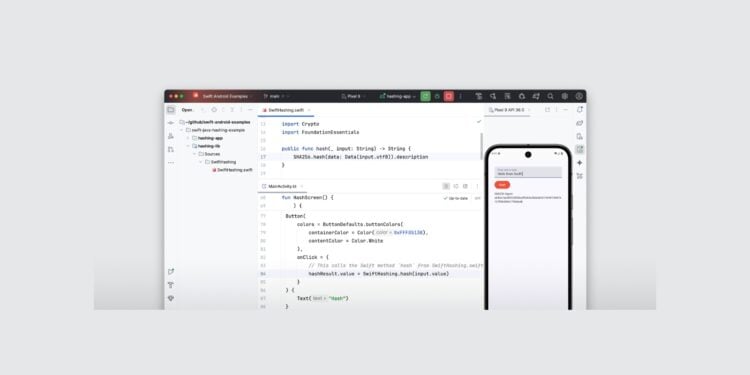Mobile app development is reaching a new milestone. For the first time, Swift, Apple's own programming language, can be officially used on Android. What was previously only possible with tricks and community solutions is now possible with Apple-supported tools. This makes cross-platform development easier, more efficient, and more professional.
For a long time, Swift was firmly tied to the Apple ecosystem. iOS, macOS, watchOS – that's what the language was developed for. Now the picture is expanding: With the new Swift SDK for Android, it's possible to write Android apps entirely in Swift. The first preview version was released this week. This allows developers to officially set up Android projects and use the same code on multiple platforms. This move comes as no surprise – back in June, it was announced that a special Android working group had been established within the Swift open source project to prepare for precisely this.
Swift SDK for Android: Official support instead of workarounds
Until now, developers had to rely on unofficial tools or complex workarounds to use Swift on Android. The new SDK eliminates this need. It offers full support for Android development with the same tools already used for iOS. This makes it much easier to share code between platforms, saving a lot of time, especially for large projects.
The SDK is currently in nightly preview and can be downloaded alongside the Swift for Windows installer or separately for Linux and macOS systems. It is cross-platform, making it easier for different developer groups to get started.
Interoperability through swift-java
A central element of the new approach is swift-java. This tool ensures that Swift and Java code can work together. It automatically generates bindings between both languages and enables access to Android APIs directly from Swift. This allows existing Java code to be reused while new components are created in Swift.
For existing projects, this means a complete switchover isn't necessary. Swift can be introduced gradually, minimizing risk while opening up new possibilities for modern code architectures.
Support from the Swift Package Index
A lot has already happened in the Swift ecosystem, too. The Swift Package Index recently started marking all packages with Android support. Currently, over 25 percent of all packages are compatible. This shows that the community is adapting quickly and a broad base for reusable modules is already emerging.
This labeling allows developers to immediately identify which packages are suitable for cross-platform projects. This not only facilitates searches but also facilitates the creation of shared code libraries for iOS and Android.
Introduction and documentation
In addition to the SDK itself, there is now also an official Getting Started Guide. It contains detailed instructions for setting up the development environment and a number of sample projects. These demonstrate complete workflows – from project initialization to the finished Android build.
This makes getting started with Swift for Android not only possible, but also practical. This makes the transition particularly straightforward for developers who already have experience with Swift from the Apple environment.
Future plans and open development
The newly formed Android working group within the Swift project is currently working on a vision document that will define future priorities. Progress and current tasks are documented on a public project board, providing a transparent overview of development.
This approach fits with Swift's open nature as an open-source project. Changes, discussions, and progress are visible to everyone. This strengthens the community and ensures that Swift continues to evolve organically as a cross-platform language.
Swift takes the next step towards cross-platform development
The new Swift SDK for Android ushers in a new era in app development. For the first time, it's officially possible to write Android apps in Swift using the same tools as on iOS. Data exchange between platforms becomes easier, development more efficient, and maintenance more manageable.
Swift has long been the heart of Apple development, but now the language is opening up to the entire mobile world. With tools like swift-java, growing support in the Swift Package Index, and an active open-source community, it's clear that Swift is no longer just an Apple technology—but a serious candidate for universal app development. (Image: Swift)
- Apple significantly expands AirPods production in India
- iOS 26.1 introduces stable photo backups for third-party apps
- Apple in leak trial: Fanboy seeks out-of-court solution
- M5 MacBook Pro teardown: top performance, repair flop
- Apple surprises with strong growth in Mac sales
- Apple accelerates US production for its own AI servers
- Vimeo expands 3D support for Apple Vision Pro
- Is Apple withdrawing app tracking protection due to EU pressure?
- Future iPhone could have greater NFC range
- iPhone Air: Production drops drastically after sales slump
- Apple stock in focus: Wells Fargo raises target to $290
- Apple Vision Pro not eligible for trade-in, according to Apple
- Apple is working on a tool for app data migration to Android
- iPhone Air weakens – Apple relies on other models





